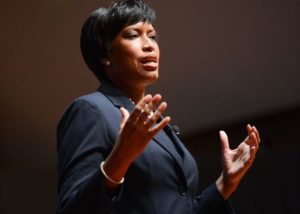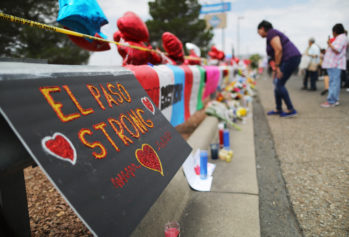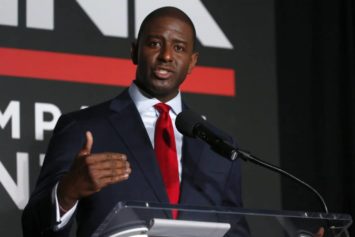
Mayor Muriel E. Bowser’s new task force would allocate additional funding for nonprofits that help vulnerable teens. Photo by Andrew Harnik/The Washington Times.
Amid public outcry over the rash of Black teens gone missing from Washington, D.C., Mayor Muriel E. Bowser announced Friday, March 24, her intention to create a task force aimed at devoting more resources to finding the city’s missing children.
The announcement comes in the wake of highly publicized news reports showing an alarming number of teens, most of whom are African-American or Hispanic, reported missing from the area in just a few short weeks. Concern sparked by the increased publicity of these cases has since prompted the Congressional Black Caucus to call on the FBI and Department of Justice to help investigate and bring the teens home.
In the district, Bowser’s efforts will increase the number of police officers assigned to locate missing children and implement a task force to determine what social services runaway and missing youths need in order to better stabilize their lives at home, The Washington Post reported. The district also would set aside additional funds for nonprofits that work with at-risk teens. The goal, a spokesman for the mayor office said, is to ensure that local organizations are working together to protect the city’s children and that the burden of doing so doesn’t fall solely on the police.
“One missing young person is one too many and these new initiatives will help us do more to find and protect young people, particularly young girls of color, across our city,” Bowser said in a statement. “Through social media, we have been able to highlight this problem and bring awareness to open cases and now we are doing more to ensure that families and children are receiving the wraparound services they need to keep families together and children safe.”
New initiatives announced by the mayor also include expanding the MPD Missing Persons webpage/social media messaging to include case catalogs with more extensive information, creating the Missing Persons Evaluation and Reconnection Resources Collaborative and a PSA announcement to support public education addressing missing youths in D.C., according to a press release.
As previously reported, 10 teens disappeared in a matter of two weeks while another has since been reported missing. Some of the teens, including 17-year-old Chareah Payne and Katherine Hunter, 17, have been located, but the whereabouts of many remain unknown.
Critics have blasted the mainstream media’s silence on the missing teens, noting that the cases would have gained national attention if the girls were white. Law enforcement officials also hav pushed back against false media reports claiming 14 girls had gone missing in just 24 hours.
Community leaders held a town hall-style meeting on March 22 to discuss the unusually high number of missing teens, where concerned residents launched harsh criticisms at local police and city leaders. Discussions became heated at some points as residents grilled local officials about why Black youths continue to turn up missing.
“If the FBI can find Tom Brady’s jersey, then they should be able to find our missing kids,” said Derrica Wilson, president of the Black and Missing Foundation.
Despite the rash of teens reported missing this month, law enforcement officials contend there hasn’t been an uptick in missing persons cases. Rather, the city’s police department has made a more concerted effort to make sure these cases are reported and receive the same amount of attention.
According to the Metropolitan Police Department, D.C. logged 501 cases of missing children in the first three months of this year, many of them Black and Latino. Thanks to the efforts of new police Commander Chanel Dickerson, acting police chief Peter Newsham and Bowser, the department has begun tweeting the names and faces of every missing person in the district, particularly those whose cases are deemed “critical.” Chronic runaways and persons 65 and older are included in this group, according to The Washington Post.
“Since Mayor Bowser took office, the number of youths reported missing has continued to decline and we have a case-closure rate of 95 percent,” Kevin Harris, spokesman for the mayor’s office said. “Despite this progress, the mayor believes that even one child reported missing is still too many, so we are doubling down and enforcing policies that better publicize when our youths go missing, invest more resources to address why youths go missing and provide more police to help investigate cases of missing youths.”
“Washington, D.C., is not alone in this issue, but what makes us unique is the concerted effort and resources we put into assisting and locating our missing youth, particularly our young people of color whose cases often do not get the same level of public attention,” he added.
Black lawmakers Cedric Richmond (D-La.), chairman of the CBC, and Eleanor Holmes Norton, who represents D.C. in Congress, have since penned a letter calling on new Attorney General Jeff Sessions and FBI Director James Comey to dedicate “the resources necessary to determine whether these developments are an anomaly or whether they are indicative of an underlying trend that must be addressed,” the Associated Press reported. Norton also said she would propose national legislation requiring the DOJ to publish detailed demographics — race, gender and sexual orientation — of children gone missing in the U.S.
Harris said these new initiatives were not sparked by public outcry or alarm raised by the media over the missing teens, though Bowser did decide to announce her new task force due to the increased attention the issue has since received.
“This is what the [social media] policy was intended to do,” he said. “It was intended to get these teens’ faces out there. It was intended to provoke conversation. We don’t ever want this to become the norm.”
The Metropolitan Police Department didn’t respond to requests for comment.


